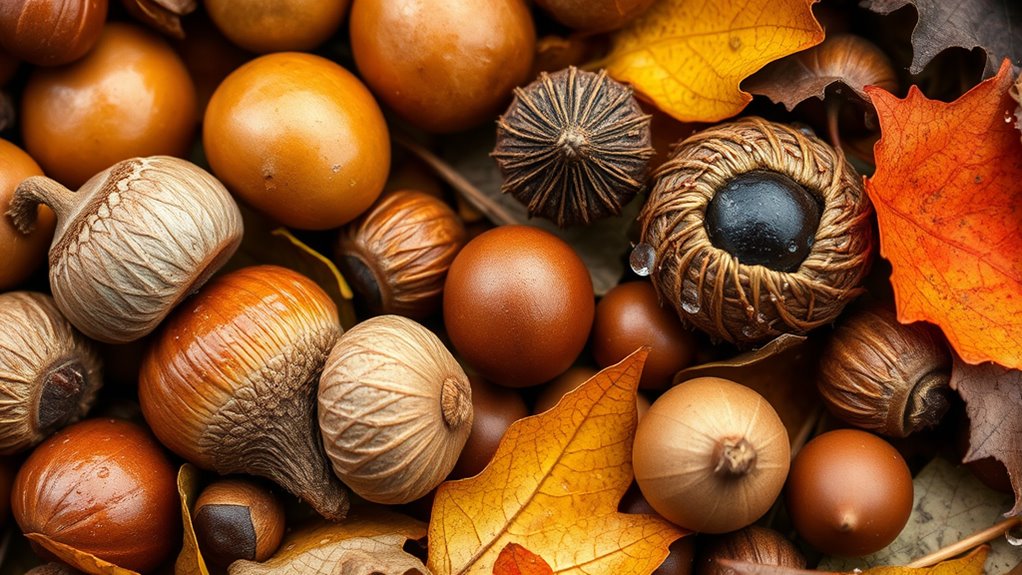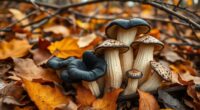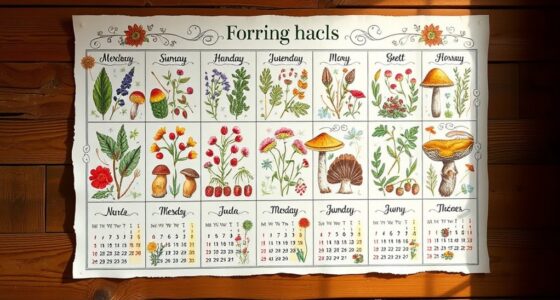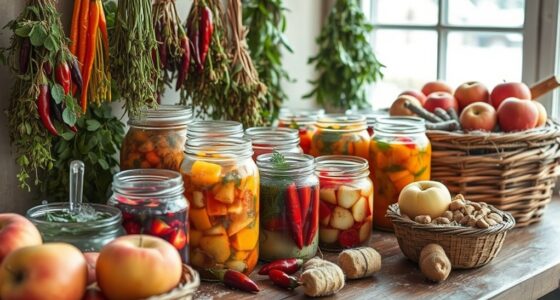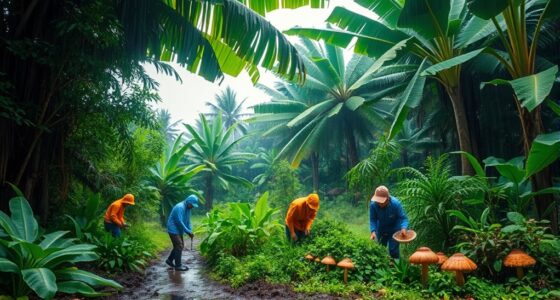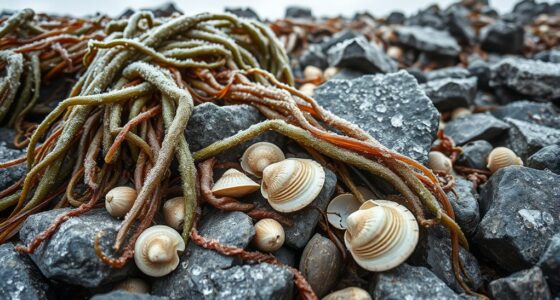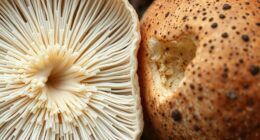In fall, you can safely gather acorns, beech nuts, and hazelnuts by first identifying ripe, fallen nuts that are free from mold or damage. Gently collect them from open, undisturbed areas, avoiding overharvesting to protect wildlife and forest health. Be mindful of local animals relying on these nuts for winter food, and consider leaching tannins from acorns before consumption. To make the most of your harvest and connect with nature’s rhythms, keep exploring these best practices.
Key Takeaways
- Identify fully fallen, undamaged nuts free from mold for safe consumption.
- Harvest from open, less trafficked areas to avoid overharvesting and habitat disturbance.
- Be aware of tannin levels in acorns; leach them properly to reduce bitterness and toxicity.
- Respect wildlife by taking only what is needed and leaving enough for animals’ winter sustenance.
- Store nuts in cool, dry places to preserve freshness and prevent mold growth.
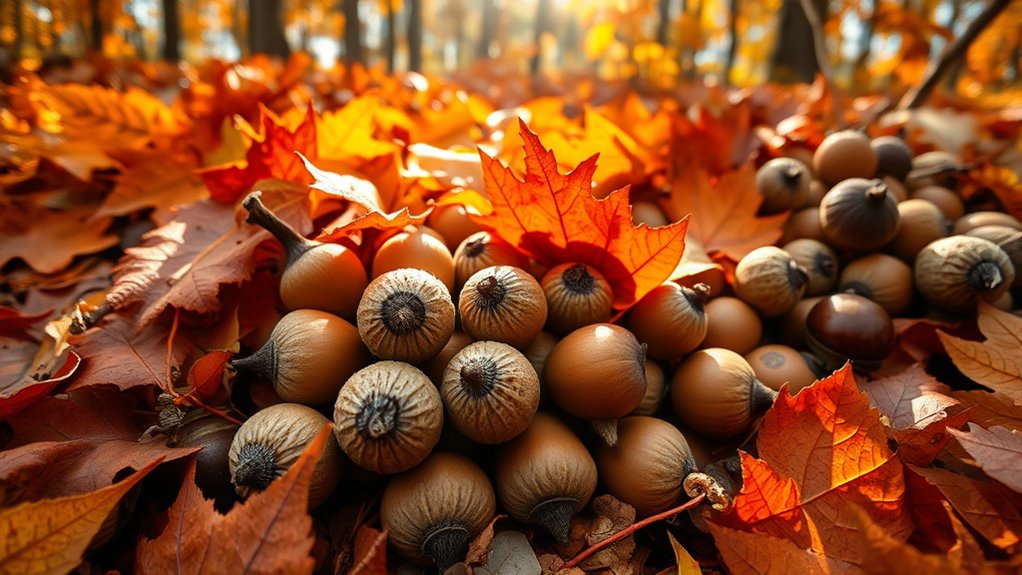
Have you ever wondered why fall is the prime season for gathering nuts and mast? It’s the time when nature’s bounty reaches its peak, offering an abundance of acorns, beech nuts, and hazelnuts ready for the taking. But if you’re seeking liberation from the constraints of conventional food sources, understanding how to harvest these wild treasures is essential. You’re not just collecting food; you’re engaging in a form of wildlife foraging that respects the land and its creatures while nourishing your body.
When it comes to harvesting techniques, simplicity and awareness are your best tools. You want to identify ripe nuts, which usually means looking for those that have fallen to the ground and show no signs of mold or damage. Gently gather them, avoiding overly crowded or heavily trafficked areas where wildlife has already foraged. This isn’t about taking everything—think of it as sharing nature’s gift rather than hoarding it. By harvesting selectively, you help maintain the balance that allows wildlife to thrive, ensuring the forest continues to produce mast year after year.
Harvest nuts mindfully by selecting ripe, fallen ones and avoiding overharvesting to support wildlife and forest health.
Wildlife foraging is a core part of this process, so you’ll want to observe the natural patterns around you. Many animals, from squirrels to deer, rely on these nuts for sustenance during winter months. Respect their space and avoid disturbing their activities. When you harvest, do so with mindfulness, taking only what you need and leaving the rest for the creatures that depend on these resources. This attitude of respect and balance allows you to connect more deeply with the land and its ecological rhythms.
Your approach to gathering should also involve understanding the terrain. Clear, open areas with plenty of fallen nuts are ideal, but avoid overharvesting in one spot. Distribute your collection across different areas to prevent depleting a single patch and to promote healthy regeneration. If you’re collecting acorns, be aware that some species are better suited for food than others, and some may contain tannins that require leaching. Beech nuts and hazelnuts are often easier to prepare, but each type has its own harvesting nuances. Additionally, understanding the importance of proper storage and preservation can help you make the most of your harvest and reduce waste.
Ultimately, your goal is liberation: freeing yourself from dependence on commercial foods and reconnecting with the natural cycle of growth and harvest. By mastering these harvesting techniques and practicing respectful wildlife foraging, you reclaim your independence and foster a deeper bond with the land. Fall becomes not just a season of gathering, but a celebration of harmony, self-sufficiency, and mindful living.
Frequently Asked Questions
Are Fall Nuts Safe for Human Consumption?
Fall nuts can be safe for human consumption if you’re aware of nut toxicity and practice proper foraging safety. Many nuts like acorns, beech, and hazelnuts are edible once prepared correctly, but some may contain toxins or anti-nutrients that require leaching or cooking. Always identify nuts accurately, avoid foraging in contaminated areas, and learn the right processing methods. With caution and knowledge, you can enjoy these natural treats freely and safely.
When Is the Best Time to Gather Acorns and Hazelnuts?
You should gather acorns and hazelnuts during their peak ripeness, which aligns with seasonal timing and masting cycles. Typically, late summer to early fall offers the best harvest window. By paying attention to masting cycles, you can time your collection for when nuts are naturally abundant and ready to harvest. This guarantees you maximize your yield, embrace the freedom of foraging, and enjoy nature’s bounty at its prime.
How Can I Identify Edible Versus Toxic Nuts?
Think of edible nut varieties as treasures hiding in plain sight, but beware of toxic nut identification, which is like reading a secret code. To tell them apart, look for specific shell patterns, colors, and signs of damage. Always consult reliable guides or experts before you harvest. You’re on a quest for freedom in nature—trust your knowledge, stay cautious, and enjoy the bounty safely.
What Tools Are Recommended for Safe Nut Gathering?
You should use sturdy nut gathering tools like a nut rake, a small hand trowel, and a basket or bucket to collect nuts efficiently. These tools help you practice safe harvesting techniques by preventing damage to trees and reducing your risk of injury. Always handle nuts carefully, and wear gloves for protection. With the right tools, you can gather nuts confidently and freely, enjoying nature’s bounty while respecting its balance.
How Should Harvested Nuts Be Stored to Prevent Spoilage?
Like a true pioneer, you master nut storage methods to prevent spoilage and free yourself from waste. Store your harvested nuts in breathable containers like mesh bags or wooden crates, keeping them cool and dry. Avoid plastic, which traps moisture and fosters mold. Regularly check for signs of spoilage, discarding any compromised nuts. This way, you stay liberated from spoilage’s hold and enjoy your bounty longer.
Conclusion
As you gather acorns, beech nuts, and hazelnuts this fall, remember to do so responsibly and safely. Some believe collecting mast can harm local wildlife or disrupt natural cycles, but research shows that careful harvesting minimizes impact. By staying informed and respectful, you support healthy ecosystems while enjoying nature’s bounty. So, go ahead—savor the season’s treasures, knowing you’re helping keep the balance intact for generations to come.

